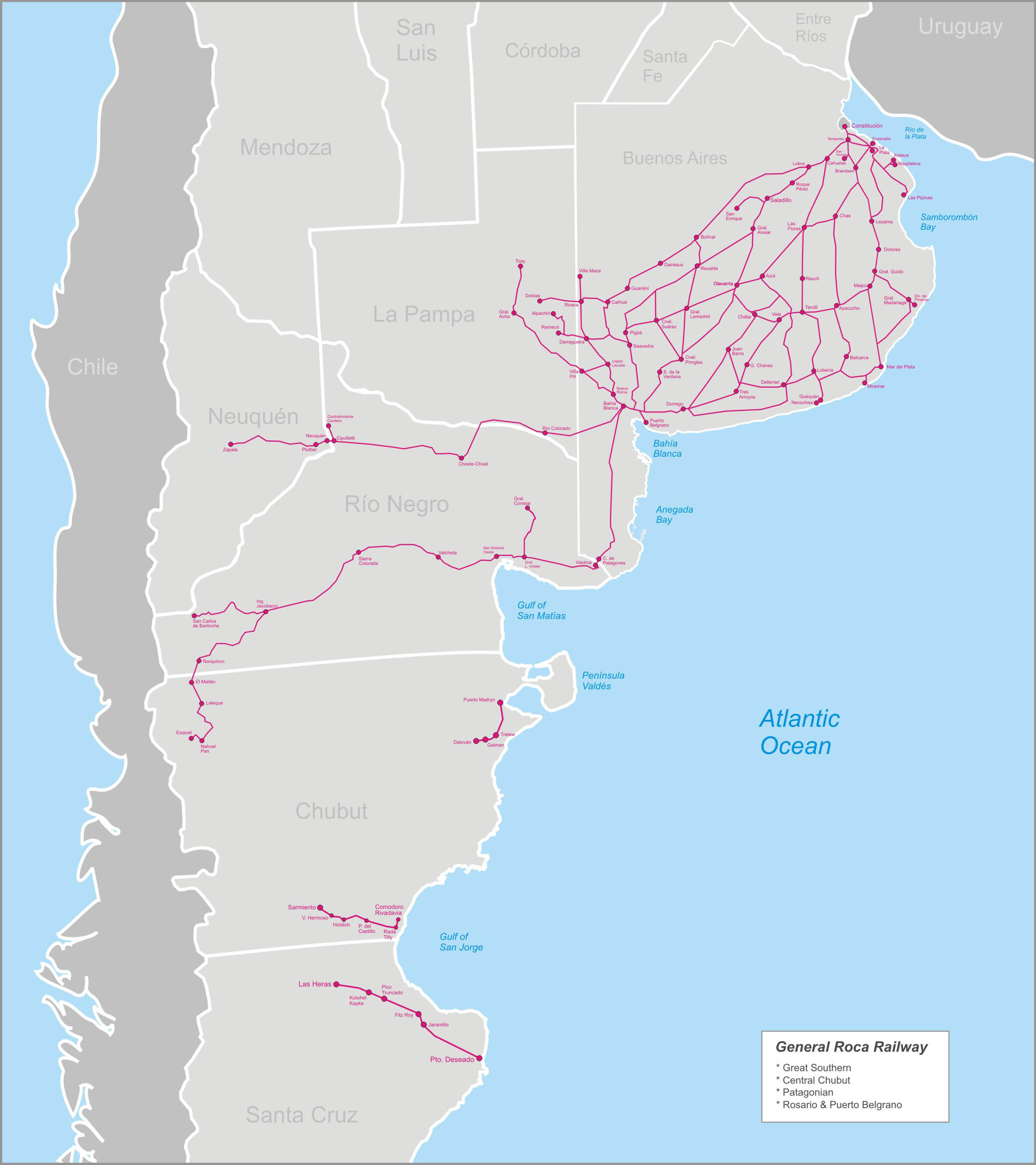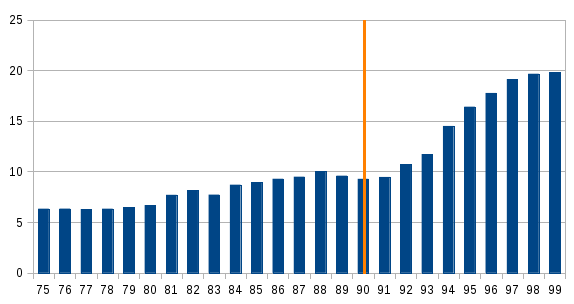|
Ferrocarril General Roca
The General Roca Railway (FCGR) (native name: Ferrocarril General Roca) is a broad gauge railway in Argentina which runs from Constitución station in Buenos Aires to the south of the country through the provinces of Buenos Aires, La Pampa, Neuquén and Río Negro. It was also one of the six state-owned Argentine railway divisions formed after President Juan Perón's nationalisation of the railway network in 1948, being named after former president Julio Argentino Roca. The six companies were managed by Ferrocarriles Argentinos which was later broken up during the process of railway privatisation beginning in 1991 during Carlos Menem's presidency. The Roca Railway is currently operated by State owned companies Trenes Argentinos (that operates commuter rail services in Buenos Aires) and Ferrobaires (for long-distance services) while freight transport is run by private companies Ferrosur Roca and Ferroexpreso Pampeano. History Background The first company to build a ... [...More Info...] [...Related Items...] OR: [Wikipedia] [Google] [Baidu] |
CNR CKD8G
The CNR CKD8 is a diesel-electric locomotive manufactured by China CNR Corporation from 2013 onwards for use in Argentina by state-owned Trenes Argentinos, a subsidiary of Ferrocarriles Argentinos S.E. The CKD8G variant is used primarily on the Roca and Sarmiento railways, while the faster CKD8H is used on the San Martín and Mitre railways. Technical specifications The locomotive has one conductor's cabin on each end, connected by an internal corridor. Its total weight is 120 tonnes with a maximum weight per axle of 20 tonnes. The four stroke 16V 4000R43 engine is manufactured by MTU Friedrichshafen and generates 2200 kW at 1800 RPM. The locomotives are divided into two sub-models, the CKD8G and the CKD8H with the latter having a higher maximum speed and tractive force. Both have six axles with independent traction engines on each one and have both air and dynamic braking systems. Purchase and usage The purchase agreement between the Ministry of Transport of Arge ... [...More Info...] [...Related Items...] OR: [Wikipedia] [Google] [Baidu] |
Broad Gauge
A broad-gauge railway is a railway with a track gauge (the distance between the rails) broader than the used by standard-gauge railways. Broad gauge of , more known as Russian gauge, is the dominant track gauge in former Soviet Union countries (CIS states, Baltic states, Rail transport in Georgia (country), Georgia, Ukraine) and Rail transport in Mongolia, Mongolia. Broad gauge of , commonly known as five foot gauge, is mainly used in Rail transport in Finland, Finland. Broad gauge of , commonly known as Irish gauge, is the dominant track gauge in Ireland, the Australian state of Rail transport in Victoria, Victoria and Railways in Adelaide, Adelaide in South Australia and Rail transport in Brazil, passenger trains of Brazil. Broad gauge of , commonly known as Iberian gauge, is the dominant track gauge in Spain and Portugal. Broad gauge of , commonly known as Indian gauge, is the dominant track gauge in Indian Railways, India, Pakistan Railways, Pakistan, Bangladesh, Sri Lanka ... [...More Info...] [...Related Items...] OR: [Wikipedia] [Google] [Baidu] |
Private Company
A privately held company (or simply a private company) is a company whose Stock, shares and related rights or obligations are not offered for public subscription or publicly negotiated in their respective listed markets. Instead, the Private equity, company's stock is offered, owned, traded or exchanged privately, also known as "over-the-counter (finance), over-the-counter". Related terms are unlisted organisation, unquoted company and private equity. Private companies are often less well-known than their public company, publicly traded counterparts but still have major importance in the world's economy. For example, in 2008, the 441 list of largest private non-governmental companies by revenue, largest private companies in the United States accounted for $1.8 trillion in revenues and employed 6.2 million people, according to ''Forbes''. In general, all companies that are not owned by the government are classified as private enterprises. This definition encompasses both publ ... [...More Info...] [...Related Items...] OR: [Wikipedia] [Google] [Baidu] |
Rail Freight Transport
Rail freight transport is the use of railways and trains to transport cargo as opposed to human passengers. A freight train, cargo train, or goods train is a group of freight cars (US) or goods wagons (International Union of Railways) hauled by one or more locomotives on a railway, transporting cargo all or some of the way between the shipper and the intended destination as part of the logistics chain. Trains may haul bulk material handling, bulk material, intermodal containers, general freight or specialized freight in purpose-designed cars. Rail freight practices and economics vary by country and region. When considered in terms of ton-miles or tonne-kilometers hauled, Energy efficiency in transport#Trains, energy efficiency can be greater with rail transportation than with other means. Maximum economies are typically realized with bulk commodities (e.g., coal), especially when hauled over long distances. Moving goods by rail often involves transshipment costs, particularly ... [...More Info...] [...Related Items...] OR: [Wikipedia] [Google] [Baidu] |
Commuter Rail
Commuter rail or suburban rail is a Passenger train, passenger rail service that primarily operates within a metropolitan area, connecting Commuting, commuters to a Central business district, central city from adjacent suburbs or commuter towns. Commuter rail systems can use locomotive-hauled trains or multiple units, using electric or diesel propulsion. Distance charges or zone pricing may be used. The term can refer to systems with a wide variety of different features and service frequencies, but is often used in contrast to rapid transit or light rail. Some services share similarities with both commuter rail and high-frequency rapid transit; examples include German S-Bahn in some cities, the Réseau Express Régional (RER) in Paris, the Milan S Lines, S Lines in Milan, many Japanese commuter systems, the East Rail line in Hong Kong, and some Australasian suburban networks, such as Sydney Trains. Many commuter rail systems share tracks with other passenger services and Cargo ... [...More Info...] [...Related Items...] OR: [Wikipedia] [Google] [Baidu] |
Government-owned Corporation
A state-owned enterprise (SOE) is a business entity created or owned by a national or local government, either through an executive order or legislation. SOEs aim to generate profit for the government, prevent private sector monopolies, provide goods at lower prices, implement government policies, or serve remote areas where private businesses are scarce. The government typically holds full or majority ownership and oversees operations. SOEs have a distinct legal structure, with financial and developmental goals, like making services more accessible while earning profit (such as a state railway). They can be considered as government-affiliated entities designed to meet commercial and state capitalist objectives. Terminology The terminology around the term state-owned enterprise is murky. All three words in the term are challenged and subject to interpretation. First, it is debatable what the term "state" implies (e.g., it is unclear whether municipally owned corporations and ente ... [...More Info...] [...Related Items...] OR: [Wikipedia] [Google] [Baidu] |
Carlos Menem
Carlos Saúl Menem (2 July 1930 – 14 February 2021) served as the 50th president of Argentina for ten years, from 1989 to 1999. He identified as Peronism, Peronist, serving as President of the Justicialist Party for 13 years (from 1990 to 2001 and again from 2001 to 2003), and his political approach became known as Menemism. Born in Anillaco, La Rioja Province, Argentina, La Rioja, to a Syrian Argentines, Syrian family, Menem was raised as a Muslim,"Carlos Menem" ''Encyclopædia Britannica'' but later converted to Catholic Church, Roman Catholicism to pursue a political career. Menem became a Peronist during a visit to Buenos Aires. He was elected governor of La Rioja in 1973, deposed and detained following the 1976 Argentine coup d'état, and re-elected in 1983. He defeated the Buenos Aires governor Antonio Cafiero in ... [...More Info...] [...Related Items...] OR: [Wikipedia] [Google] [Baidu] |
Railway Privatisation In Argentina
Railway privatisation in Argentina was a process which began in 1989 under the presidency of Carlos Menem, following a series of neoliberalism, neoliberal economic reforms. This primarily consisted of breaking up the state-owned railway company Ferrocarriles Argentinos (FA) and allowing the former lines to be operated by private companies instead of the state. This policy was met with widespread criticism and proved catastrophic for the Argentine railways whose service worsened significantly in the years that followed, with entire lines closing and infrastructure deteriorating beyond repair. Privatisation was ultimately reversed in 2015 with the creation of Nuevos Ferrocarriles Argentinos. Background Since railway nationalisation in 1948, during the presidency of Juan Perón, the network had been operated by the state-owned company Ferrocarriles Argentinos (FA) which comprised the six relatively independent divisions, Domingo Sarmiento Railway, Sarmiento, General Bartolomé Mi ... [...More Info...] [...Related Items...] OR: [Wikipedia] [Google] [Baidu] |
Ferrocarriles Argentinos
Ferrocarriles Argentinos (abbreviated as FA; ) was a government-owned corporation, state-owned company that managed the entire Rail transport in Argentina, Argentine railway system for nearly 45 years. It was formed in 1948 when all the private railway companies were Railway Nationalisation in Argentina, nationalised during Juan Perón's first President of Argentina, presidential term, and transformed into the ''Empresa de Ferrocarriles del Estado Argentino'' (EFEA; ). FA managed both passenger trains, passenger and freight rail transport, freight services, including long-distance and commuter rail trains in the metropolitan area of Buenos Aires. The company was broken up under the government of Carlos Menem following the Railway privatisation in Argentina, privatisation of the railways; however in 2015 the government of Cristina Kirchner revived the brand for use on state-owned railways. [...More Info...] [...Related Items...] OR: [Wikipedia] [Google] [Baidu] |
Julio Argentino Roca
Alejo Julio Argentino Roca Paz (July 17, 1843 – October 19, 1914) was an Argentine army general and statesman who served as President of Argentina from 1880 to 1886 and from 1898 to 1904. Roca is the most important representative of the Generation of '80 and is known for directing the Conquest of the Desert, a series of military campaigns against the indigenous peoples of Patagonia sometimes considered a genocide. During his two terms as president, many important changes occurred, particularly major infrastructure projects of railroads and port facilities; increased foreign investment, along with immigration from Europe and particular large-scale immigration from southern Europe; expansion of the agricultural and pastoral sectors of the economy; and laicizing legislation strengthening state power. Roca's main foreign policy concern was to set border limits with Chile, which had never been determined with precision. In 1881 Argentina gained territory by treaty with ... [...More Info...] [...Related Items...] OR: [Wikipedia] [Google] [Baidu] |






